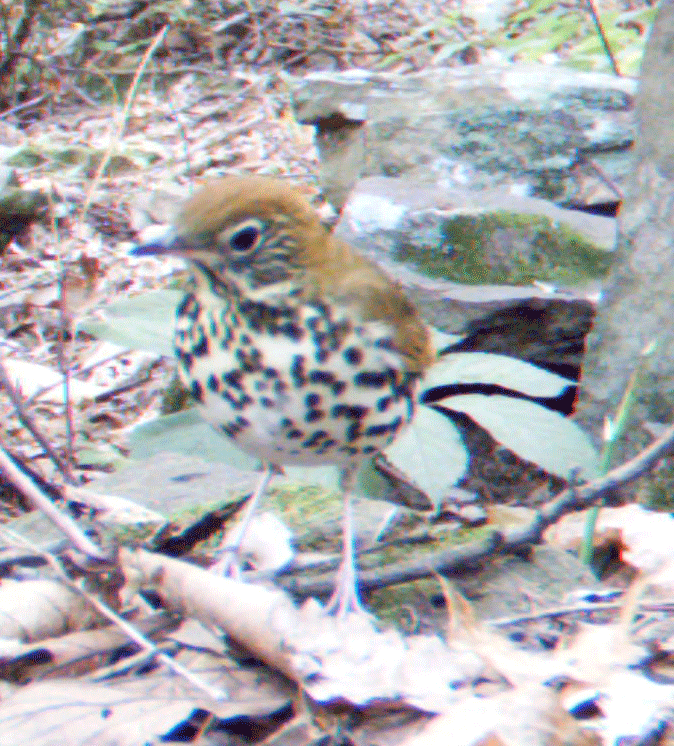
Threats to Wild American Ginseng
Loss of Seed Dispersers
Many animals interact with American ginseng, but until the invention of trailcams, it was not clear which ones, if any, ate the seeds. In addition, even if the seeds were eaten, would they survive in the digestive tract of the animal to be dispersed in a viable condition?
As it turns out, by examining photos from trailcams aimed at fruiting ginseng plants, Sara Souther, James McGraw, and Amy Hruska were able to show that birds and small mammals ate ginseng fruits, but only a small family of birds dispersed the seeds. The eastern chipmunks eat the berries, but usually, the seeds did not survive intact. However, when fruits are abundant, they may occasionally be cached (buried in the soil), then be forgotten, and later germinate in a small group.

Wood Thrush & American ginseng, from study trail cam.
Credit: McGraw Labs, WVU

Eastern chipmunk inspecting American ginseng,
from study trail cam. Credit: McGraw Labs, WVU

Eastern chipmunk beside American ginseng from study trail cam.
Credit: McGraw Labs, WVU
The true seed dispersers of ginseng are a family of well-known forest birds called thrushes. Hermit thrush, Wood thrush, Swainson’s thrush, and Veery were found to inspect berry clusters, and pluck the ripe red fruits from the plant. Did the seeds survive? To find out, Amy Hrushka fed fresh red berries to captive thrushes. She discovered that thrushes regurgitate the seed after a 15 – 37 minutes, and later tests showed they were perfectly viable. While the seed was carried inside the thrush, any movement of the bird would result in dispersal.
In a later study, undergraduate Mike Elza found that non-migrating thrushes could carry seeds the length of a football field!
The sad part of this wonderful story is that thrushes are in decline. Wood thrushes, for example, have declined 55% in less than 50 years. Therefore, ginseng is losing one of its primary ways of spreading to new areas or areas it once occupied. Dispersal now occurs over shorter distances. This in turn lowers the number of new populations formed and reduces the ability of ginseng to escape local habitat stressors.

Woodthrush & American ginseng ~ TWO BERRIES from study trail cam.
Credit: McGraw Labs, WVU
References
Hruska and McGraw (in prep)
Elza, M. C., C. Slover, and J. B. McGraw. 2016. Analysis of wood thrush (Hylocichla mustelina) movement patterns to explain spatial structure of American ginseng (Panax quinquefolius) populations.
Hruska, A. M., Souther, S., and J. B. McGraw. 2014. Songbird Dispersal of American ginseng (Panax quinquefolius).
Meyer, A. 2016. Smithsonian scientists solve puzzle of dramatic wood thrush decline. Smithsonian Insider.
What can you do to encourage seed dispersers?
(1) If you are a landowner, help to create or preserve wildlife habitat.
(2)Encourage holistic ecosystem management for the good of all biodiversity.
American ginseng and wood thrush.
Credit: Watercolor painting by Susan Bull Riley

Further Reading
A Land Manager's Guide to Improving Habitat for Forest Thrushes, Cornell Lab of Ornithology
Forest Bird Pocket Guide 18 Priority Species for Pennsylvania Foresters & Landowners, Audubon PA
Guidelines for Managing Wood Thrush and Scarlet Tanager Habitat in the Northeast and Mid-Atlantic Regions, High Branch Conservation Services and Plymouth State University
Managing Forests for Birds, Mass Audubon